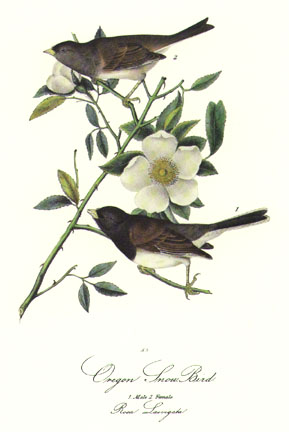

168 OREGON SNOWBIRD
| This species, which is so nearly allied to our Common Snow-bird, is
another of those recently added to our Fauna by Mr. TOWNSEND, from whom
I purchased several specimens. All that I know of its habits is derived
from the following notice given me by Mr. NUTTALL. "It was first
seen by us in the woods of the Columbia, in the autumn and winter,
flitting about in small flocks, always in the forest, never in the open
fields, or on the way-sides. At this time they rarely utter an
occasional chirp, or remain wholly silent. We afterwards saw them
inhabiting the same woods throughout the summer, in diminished numbers,
or in pairs, but I do not recollect hearing them utter any song, though
they are probably not silent in the season of breeding. With the nest,
eggs, and young I am not acquainted."
I have represented the male and female from specimens procured by Mr. TOWNSEND on the Columbia river, on the 5th of October, 1834. Columbia river. Common. Migratory. FRINGILLA OREGONA, Oregon Snow-Finch, Towns., Jour. Acad. Nat. Sc. Philadelphia, vol. vii. p. 188. OREGON SNOW-FINCH, Fringilla Oregona, Aud. Orn. Biog., vol. v. p. 68. Adult Male. Bill short, rather small, conical, considerably compressed, acute; upper mandible a little broader than the lower, its dorsal line straight, slightly declinate at the tip, the sides convex, the edges slightly inflected, but overlapping; the gap-line straight; lower mandible with the angle short and rounded, the dorsal line straight, the sides convex, the edges a little inflected, the tip acute. Nostrils basal, roundish, concealed by the feathers. Head rather large, broadly ovate; neck short; body full. Feet of moderate length; tarsus rather short, stout, with seven anterior scutella, of which the upper are blended, sharp-edged behind; toes rather strong, the first stout, the middle one considerably longer than the lateral, which are equal; claws rather long, arched, compressed, laterally grooved, tapering to a fine point. Plumage very soft and blended. Wings shortish, curved, rounded, the first quill three and a half twelfths of an inch shorter than the second, which is half a twelfth shorter than the third, and about the same length as the fourth; the secondaries rounded. Tail rather long, slightly emarginate. Bill reddish-white, the tip dusky. Iris hazel. Feet and claws flesh-coloured. The head, neck all round, and a portion of the breast black, the feathers faintly margined with grey; the rest of the lower parts white, excepting the sides, which are tinged with brown. The fore part of the back is dark reddish-brown, the hind parts dull grey. The smaller coverts, secondary coverts and inner secondaries are dusky, with broad light-brown margins; the primary coverts and the rest of the quills brownish-black, narrowly edged with brownish-white. The tail is of the same dark colour as the wings, excepting the two outer feathers on each side, which are white; the second, however, having a part of the outer web dusky, and the third having a white streak on the inner web toward the end. Length to end of tail 6 1/4 inches; bill along the ridge (4 3/4)/12; wing from flexure 3 1/12; tail 2 (7 1/2)/12; tarsus 10/12; hind toe 4/12, its claw (4 1/2)/12; middle toe (7 1/2)/12, its claw (3 3/4)/12. Adult Female. The female has the bill and feet coloured like those of the male. The head and neck are blackish-grey, the feathers edged with paler; the back and wing-coverts dull reddish-brown; the wings and tail as in the male; the breast and abdomen white, the sides pale reddish-brown. Length to end of tail, 5 3/4 inches; bill along the ridge 5/12; wing from flexure 3; tail 2 7/12; tarsus (9 1/2)/12; hind toe and claw (6 1/2)12; middle toe and claw (9 1/2)/12.
|